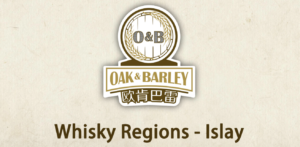 Previously we have shared articles about the Highlands, Lowlands and Speyside regions of Scotch whisky. Now it’s time for Islay.
Previously we have shared articles about the Highlands, Lowlands and Speyside regions of Scotch whisky. Now it’s time for Islay.



 Islay is a Scottish island famous for its unique style of whisky production. At around 25 miles long, and 20 miles at its widest, this little island packs a punch on the world whisky stage with their iconic brands. It’s a whisky lover’s delight as can be seen by the huge amount of whisky lovers that visit Islay every year.
Islay is a Scottish island famous for its unique style of whisky production. At around 25 miles long, and 20 miles at its widest, this little island packs a punch on the world whisky stage with their iconic brands. It’s a whisky lover’s delight as can be seen by the huge amount of whisky lovers that visit Islay every year.



 Islay single malts reflect the nature of the Island itself. They’re famous for being “peated”, with smokey notes resulting from the way the barley is dried using peat as a fuel and heat source. Other common notes reflect the maritime nature of Islay, with seaweed, brine and other maritime flavours.
Islay single malts reflect the nature of the Island itself. They’re famous for being “peated”, with smokey notes resulting from the way the barley is dried using peat as a fuel and heat source. Other common notes reflect the maritime nature of Islay, with seaweed, brine and other maritime flavours.
 The island is covered in peat which is exposed to rain and sea spray. Harvested and used to malt the barley used in distilling, the peat and the maritime climate gives Islay whiskies their characteristic pungent peaty, smoky and oily flavours, with just a hint of salty sea air and seaweed. The island is probably most famous for the ‘big smokes’ of Laphroaig, Lagavulin and Ardbeg.
The island is covered in peat which is exposed to rain and sea spray. Harvested and used to malt the barley used in distilling, the peat and the maritime climate gives Islay whiskies their characteristic pungent peaty, smoky and oily flavours, with just a hint of salty sea air and seaweed. The island is probably most famous for the ‘big smokes’ of Laphroaig, Lagavulin and Ardbeg.
 FUN FACT – Ireland calls peat, “turf” and historically used the same fuel source to dry malted barley. Although modern Irish whiskies are less famous for peating their malts in modern times, there is something of a resurgence in recent years of whiskies made in this style. However, they still use the term “peated” as opposed to “turfed”.
FUN FACT – Ireland calls peat, “turf” and historically used the same fuel source to dry malted barley. Although modern Irish whiskies are less famous for peating their malts in modern times, there is something of a resurgence in recent years of whiskies made in this style. However, they still use the term “peated” as opposed to “turfed”.





1. Ardbeg – producing one of the most peated drams on Islay
The Ardbeg distillery was officially founded in 1815 by John McDougall. But Whisky was distilled long before that. There are no documentations, as Ardbeg was an illegal business back in 1794.
The Whiskies of Ardbeg are usually heavily peated Malts. Compared to other Islay Malts Ardbeg doesn’t focus on the sea and salt tastes. They rather focus on aromas of spices, malt or sweet tones like vanilla and chocolate.
The core range of Ardbeg consists of the Ardbeg TEN, Uigeadail and Corryvreckan. The TEN is named after its age. Uigeadail was named after the Loch Uigeadail a lake. The Corryvreckan is a famous sea vortex between the Isle of Jura and the Isle of Scarba.
Recently the Ardbeg distillery brought out quite a number of special releases with no age statement (Supernova, Ardbog, Alligator). These bottles are highly advertised, quite special in taste and very limited to in quantity.
 Whisky Introductions:(Click on the picture for details.)
Whisky Introductions:(Click on the picture for details.)
Ardbeg Renaissance:The Ardbeg Renaissance is the last of a series that was dedicated to building up the peaty maturity of the Ardbeg 10 Year. Each expression was released at different periods of the whisky’s maturation that began with Very Young, Still Young, Almost There, and completes with “We’ve Arrived” Renaissance. It was distilled in 1998 and bottled in 2008 at cask strength.
Ardbeg Wee Beastie 5 Year Old:An untamed young single malt from Ardbeg, Wee Beastie has spent five years in a combination of ex-bourbon and ex-sherry casks before being unleashed. Fresh, herbal aromas of pear, cracked black pepper, pine needles, vanilla and honey-glazed ham mingle on the nose with aniseed, green apple, leather and coffee. The palate offers notes of dark chocolate, hot tar, smoked bacon, aniseed and eucalyptus that liner in the finish.
2. Bowmore – the oldest distillery on Islay and located in the island’s capital
 Whisky Introductions: (Click on the picture for details.)
Whisky Introductions: (Click on the picture for details.)
Bowmore 12:Bowmore 12 is the heart of the Bowmore range, the 12-year-old exhibits some beautiful coastal notes with a gentle peat, it is the balance that the floral element presents that makes this a great entry bottling for Bowmore.
Bowmore Prime Blue:Prime Blue is one of the most widely available whisky brands in Taiwan, selling over one million bottles per year. Apparently it’s somewhat hard to come by outside of the Asia-Pacific region. The Prime Blue is a vatted malt that’s distilled and bottled in Scotland by Morrison Bowmore and is owned by Japan’s Suntory Group.Overall it’s a quality sipping whiskey for the price.
3. Bruichladdich – re-opened in 2000
One of two distilleries on the Rhinns of Islay, the western peninsula of the island, Bruichladdich was founded in 1881. Over the past 130 years, the distillery has changed hands many times and had frequent closures, but since 2000 it has been reborn, and is yet again at the forefront of Scottish whisky distilling.
The distillery was mothballed in 1995 and left dormant for the next five years. In 2000, the distillery was bought by Murray McDavid, and Islay-born Jim McEwan, formerly Bowmore manager, rebuilt and restarted the distillery. Initially mainly producing unpeated whisky, the distillery introduced two extra makes – heavily peated Port Charlotte and ridiculously smoky Octomore. The Elements range bottle each of the three separately under their own distillery symbol.
 Whisky Introductions:(From left to right)
Whisky Introductions:(From left to right)
Bruichladdich The Classic Laddie:Bruichladdich The Classic Laddie is created by Jim McEwan from whisky matured in American oak casks alongside Lochindaal. And chosen to represent the classic, unpeated distillery style. Bruichladdich’s new signature bottling is made with 100% Scottish barley.
Port Charlotte 10:Introduced as the flagship Port Charlotte expression produced by Bruichladdich in 2018, this 10-year-old single malt from the Isle of Islay is a lip-smackingly smoky number indeed. It’s peated to 40ppm, and drawn from a combination of first-fill American ex-bourbon casks, second-fill American whisky casks, and French wine casks.
4. Caol Ila – the largest distillery on Islay
 Whisky Introductions:(From left to right)
Whisky Introductions:(From left to right)
5. Lagavulin – sitting proud on Lagavulin Bay
Peter Mackie, creator of the White Horse blend, owned the distillery in the late 1800s and was also the sales agent for Laphroaig. When he lost the agency in 1907, he decided to build a new distillery at Lagavulin that would make whisky that was identical to Laphroaig – the legendary Malt Mill. Unfortunately his planned failed, and the whisky was entirely unlike Laphroaig and Malt Mill closed, appearing only in tales of rare whisky, including Ken Loach’s film The Angel’s Share.
The whisky produced at Lagavulin has a range of personalities. The stills are run very full, which reduces the amount of copper contact the spirit has, and the distillation is slow. Both of these are factors in creating the distillery’s versatile and weighty spirit. Maturation is mostly in bourbon casks, with a few ex-sherry casks used to create the signature character of Lagavulin’s older whiskies.
In its youth, the distillery’s whisky is feisty and raw, with huge seaside smokiness; but as it ages, it quickly gains weight and elegance, with the official 16-year-old release well known as one of Islay’s most consistently excellent drams.
 Whisky Introductions:(From left to right)
Whisky Introductions:(From left to right)
Lagavulin 10 Year Old:A 10-year-old Lagavulin single malt, originally released as a Travel Retail exclusive, this whisky has been matured in first-fill American oak casks. Aromas of rock salt, crunchy red apples, burnt sugar and savoury peat smoke fill the nose, complemented by notes of roast almonds, spicy chilli flakes and waves of salty smoke throughout the palate.
Lagavulin 16:A much sought-after single malt with the massive peat-smoke that’s typical of southern Islay – but also offering richness and a dryness that turns it into a truly interesting tipple. The 16 year old has truly become a benchmark Islay dram from the Lagavulin distillery.If you’re looking for a meal pairing for this beauty, try intensely flavoured salty blue cheeses, which complement the intense, peat rich, sweet and salty character of this Lagavulin wonderfully.
6. Laphroaig – the most famous peated whisky in the world
Laphroaig is also the only whisky distillery awarded a Royal Warrant by Prince Charles, issued during his first visit to the distillery in 1994. He followed up with a repeat visit in 2008 as part of his 60th birthday celebrations.
 Whisky Introductions:(From left to right)
Whisky Introductions:(From left to right)
Laphroaig Select Cask:For the Laphroaig Select, the Islay distillery has taken whisky from a number of different types of cask, including Oloroso Sherry butts, white American oak, Pedro Ximenez seasoned hoggies, Quarter casks and first fill bourbon casks. Quite a “selection”, wouldn’t you say? A laid-back addition to the Laphroaig core range of single malts.
Laphroaig Four Oak:Laphroaig Four Oak is, perhaps unsurprisingly, a blend of whisky matured in four different types of cask: ex-bourbon barrels, small quarter casks, virgin American oak barrels and European oak hogsheads. This is a 1000ml bottle.
7. Bunnahabhain – a remote distillery producing a non-peated whisky
The word ‘Bunnahabhain’ means river mouth. Bunnahabhain was build in 1881 by the Greenless Brothers and is still the most norther Distillery on the Isle of Islay.
The Bunnahabhain Whiskies are lightly peated Islay Malts that have a lot of salty marine tones. The distillery bottling range has many Whiskies ranging from the 12-year-old to the 40-year-old. There are also a few no NAS bottlings that have different tastes.There are many independent bottlings of the Bunnahabhain distillery.
 Whisky Introductions:(From left to right)
Whisky Introductions:(From left to right)
Bunnahabhain 12 Year Old:Double Matured in Ex Bourbon and Ex Sherry Casks, this whisky is beautifully rich and full-bodied, achieving the perfect balance of the characteristic nutty and sherry flavours of Bunnahabhain.
8. Kilchoman – a tiny farm distillery
 Whisky Introductions:(From left to right)
Whisky Introductions:(From left to right)
Kilchoman Sanaig:A handsome release from Islay’s newest distillery, Kilchoman Sanaig is an enjoyably peaty single malt which has been vatted from both bourbon and Sherry casks. It’s named after a small, rocky creek rather near the distillery on the west coast of the island. Look out for plenty of fruit and earthy peat coming through on this one, with a touch of dark chocolate-covered raisins.
Kilchoman Machir Bay:Kilchoman Machir Bay is a good single malt Scotch whisky from the isle of Islay. The distillers use whisky that has been matured in ex-bourbon barrels and Oloroso Sherry butts. Resulting in a well-balanced flavour profile, with highlights of vanilla biscuits, light fruit and wafts of warm peat smoke.A top expression from Islay’s farm distillery.
9. Ardnahoe
Ardnahoe Distillery is one Scottish family’s dream unfolding as well as being the next chapter in the captivating story of the Whisky Isle of Islay.
The Laing family, having been involved in the Scottish whisky industry for generations, are highly respected in their field. As a young man in the 1960’s Stewart Laing came to work at the Bruichladdich Distillery where he began to learn the fine art of distillation. It was here, on the island, his love for Islay and its whisky was ignited.
Stewart’s two sons, Andrew and Scott, are following in their father’s footsteps – making Ardnahoe a wholly family-owned business: a rarity in today’s scotch whisky industry.
Ardnahoe prides itself on being a modern distillery, set beautifully in a stunning location, that employs rigorously traditional methods and values. The spirit being produced is sweet, smoky and smooth yet peaty and spicy – unique and dynamic to its very core.




















